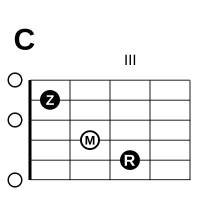Guitar/Chord changes C-Am
This page is currently being translated from Germans Wikibooks into English. • Expect some errors and inconsistencies. •Images has to be repainted. The German fingering ZMRK = imrp (Z = Index, K = small Finger = pinKy •Some German words in pictures has to be translated. • Give the author some time to correct the deficiencies. • Assisted the translator because he is not a native speaker. Feel free to correct mistakes and style. • The Wikitorians among you may help me with the peculiarities of English Wikibooks. (how do you handle things, what are your preferd templates...). •delete {:Guitar/under construction - in translation}if you think the translation is largely error-free and good enough.• Be patient. The translation of the finished German lesson (links in the navigation) will take time. |
Original page translated by Google
Relative minor Am[edit | edit source]
The change between C major and A minor (Am for short) is even easier than the change between G and Em.
Only one finger is moved between C major and Am.
This makes it very easy to remember that Am is the relative minor to C.
| Key G major with minor parallels |
|||||
From C to Am and back[edit | edit source]
 |
  |
 |
From C to Am
|
 |
From Am to C
|
 |
  |
 |


The 2-5-1 chord progression[edit | edit source]
In the key of G major, the chord C major is the subdominant. Am is the relative minor of C major, so Am is the relative subdominant.
The relative subdominant can be used very well as an announcer ("herald") of the exciting dominant.
Suppose a song contains the chord sequence D(7) G (dominant - tonic). In such a case, the relative subdominant Am very often announces the dominant D(7). You can gain momentum with the Am to D(7) in order to then end up at G again. So Am D(7) G.
If you count through the G major scale
1 2 3 4 5 6 7 8(=1) G A H C D E F# G
then you will see that G is on the first degree, A (and Am) on the second degree and D on the fifth degree. The chord progression Am D(7) G is therefore a II-V-I chord progression (2-5-1 in Roman numerals). This chord progression occurs very frequently. It is also particularly popular as a final turn at the end of a verse, a chorus or at the end of a song, or as a transition from the end of a verse with Am D to the beginning of the next verse again with the tonic G. A chord progression, which leads back to the tonic, is a "turnaround". It's worth paying attention to this. It is always easier to memorize a whole standard chord progression than three seemingly independent chords. After a while, you will see and hear this II-V-I connection on your own.

Examples of a II-V-I chord progression[edit | edit source]
- Killed[Am]poor Laura[D]Foster. - You know you're bound to[G]die. (Tom Dooley)
- And I[G]never will[Am]play THE WILD[D]ROVER no[G]more
- [Am]saying SOMETHING[D]STUPID like I[G]love you
- and I[Am]mean it from the[D]bottom of my[G]heart (I just call to say I love you)
- DON'T[Am]WORRY,[D]BE[G]HAPPY
In the last lessons you learned the chord progression G-Em-C-D. You also learned here that C major can sometimes be replaced by Am. And you learned that Am can herald the dominant D. So just try replacing the chord progression G-Em-C-D with the chord progression G-Em-Am-D. You'll find that in most cases it works without any problems, so it will be a matter of taste later on whether you use one or the other variant.
Em - Am[edit | edit source]
Even if the chord change Em Am doesn't cause any significant problems, you can practice it several times in isolation if necessary:
- Lift all fingers
- Both fingers goes simultaneously down one fret
- Index finger in the correct position (same like in C major)
- Lift all fingers
- Index and middle fingers goes simultaneously up one fret.



